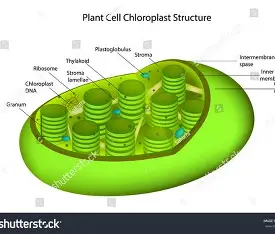Lab photosynthesis
1/33
There's no tags or description
Looks like no tags are added yet.
Name | Mastery | Learn | Test | Matching | Spaced |
|---|
No study sessions yet.
34 Terms
Photosynthesis
process by which green plants, algae, and some bacteria convert light energy into chemical energy stored in glucose
two stages of photosyntheis
Light reaction cycle and Calvin cycle
Light reaction cycle
light absorption in the pigments and breaking H2O molecules, releasing O2 as a byproduct. ATP and NADPH are produced. Occurs in the inner thylakoid membrane
The calvin cycle
uses CO2 to create glucose by using the ATP and NADPH from earlier. Occurs in the stroma
photosynthesis equation
6CO2 + 6H2O + light energy —> C6H12O6 +6O2
photosynthesis occurs in
chloroplasts

chlorophyll
pigment in chloroplasts that captures light energy
pigments
capture light energy and convert it to chemical energy
chlorophyll a
absorbs blue violet and red light, reflects green wavelengths
chlorophyll b
accessory pigment, absorbs blue and red orange light, reflects green-yellow wavelengths
carotenoids
accessory pigments, absorb blue and green, reflect yellow, orange, or red ex. beta carotene
once pigments absorb light the energy is transferred to the
reaction center, where it excites electrons
High energy electrons are used in the light reaction to produce
ATP and NADPH
Paper chromatography
technique for the separation and identification of different plant pigments. The mixture containing the pigments to be separated is first applied as a spot or line to the paper about 1.5cm from the bottom of the paper. Then the paper is placed in a container with the tip of the paper touching the solvent. The pigments are carried along at different rates because they are not equally soluble. Less soluble pigments move slower up the paper than more soluble pigments. More polar the pigment, the further up it will move.
Carotene
Rf value of .8, band yellow to yellow orange
Xanthophylls
.18 rf, yellow band
Chlorophyll a
.6 rf, green to blue green band
chlorophyll b
.4 rf, green to yellow green band
isopropanol
the solvent
most nonpolar pigment
carotene
if elodea plants are actively undergoing photosynthesis, the CO2 in the solution will disappear
Phenol red
pH indicator, yellow- acidic, more CO2, red-neutral, less CO2
when you blow in the solution it turns yellow
the CO2 from your breath dissolves in the water forming carbonic acid which lowers the pH
if a plant is photosynthesizing the solution will turn red
the plant uses the CO2, raising the pH
sunlight includes
visible light, UV, Infrared, X rays, radio waves, gamma rays
a white lighbulb wavelength
400 to 700 nm, combo of visible light
elodea plant most useful wavelengths are
red and blue
we can measure light reaction O2 release in
volumeter apparatus
stomata
microscopic structures found on the epidermis of plant leaves, stems, and other aerial organs. They serve as the primary route for gas exchange, regulating intake of H2O and O2 and release of O2.
structure of stomata
2 specialized guard cells flanked by neighboring epidermal cells.
Guard cells
can change shape which regulates the opening and closing of the stomatal pore
Guard cells swell and become turgid
gap created, allows exchange of gases
guard cells loose turgor pressure
pore closes, excess water loss prevented
banding is caused by
speed the pigment is moving